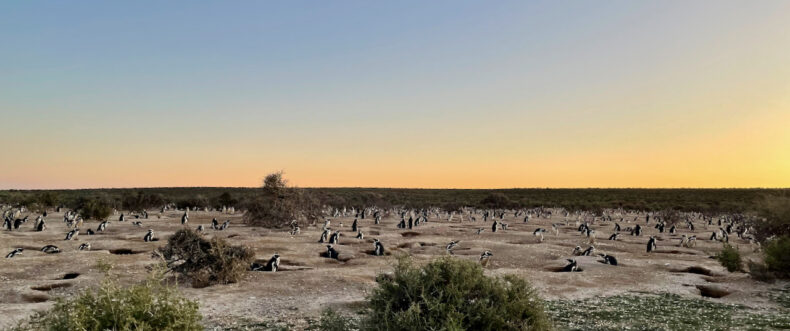
I arrived under a cloud. The arrival was at Punta Tombo, a colony of Magellanic penguins on the coast of Argentina. It was the 2nd of October. Hundreds of thousands of penguins, most of them males, had been coming ashore for about two weeks, marking the start of the breeding season. While they waited for the females, they had busied themselves claiming nests, braying incessantly, bill-dueling, and in general just sizing each other up in the way penguins do. Now the females were starting to arrive, either to return to their old mates or to choose new ones. Thus the frenetic air to the place.
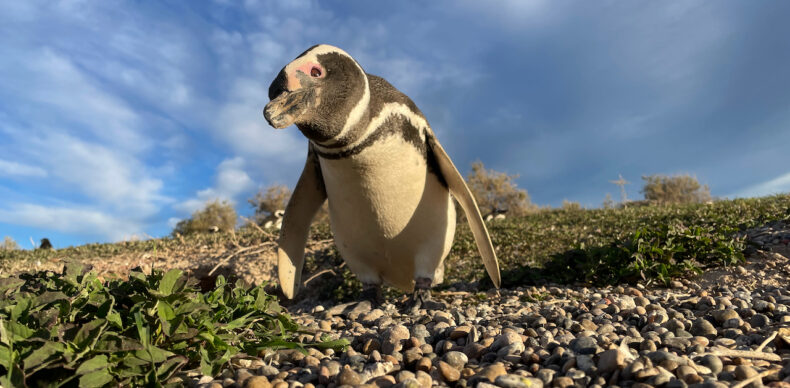
The cloud was highly pathogenic avian flu, or HPAI, known more widely as bird flu. Since the fall of 2020, the H5N1 strain of bird flu had swept around the northern hemisphere, killing hundreds of thousands of seabirds. At first it had been largely confined to colonies in Europe and North America, but in the fall of 2022 it appeared in South America. It raced down the Pacific coast from Peru to southern Chile, leaving in its wake many more thousands of dead birds: pelicans, boobies, cormorants, penguins, others. The sheer scope of death was hard to comprehend. Whole colonies had been devastated in just weeks. Now it had made its way to the Atlantic coast. Thus the air of impending doom.
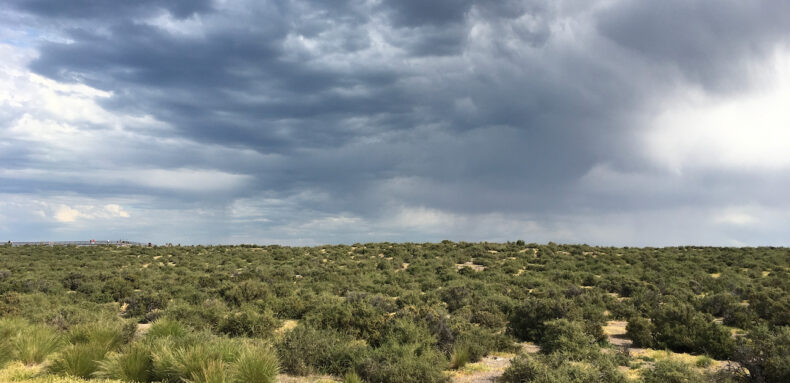
I was to be at Tombo for a month. I joined Katie and Chloe, both from the University of Washington. They had been here since mid-September with Dee Boersma, who has studied the penguins at Tombo for more than forty years. Although a couple of dozen dead sea lions had greeted them all on their arrival—a variant of H5N1 had developed that infected marine mammals, with similarly severe consequences—to date they had not seen a single sick penguin. We all worried, though, that it was just a matter of time before bird flu showed up.
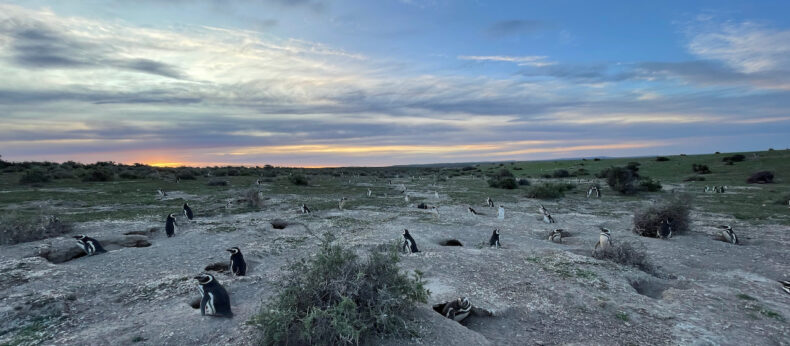
There was one penguin in particular on my mind: Turbo. I had met him in 2008, when I first came to Tombo as Dee’s graduate student. Turbo’s origin story was well known in the lab. In 2005, as a young male, he had secured himself a nest in a bush near the field house. The nest was a good one, and another male wanted it. He and Turbo fought. Turbo lost. Needing a new nest, he moved under the large pickup truck parked next to the house: a Ford F150 Turbo. Hence, Turbo. More remarkably, he lost all interest in other penguins as mates, taking to people instead. He visited the field house, hobnobbed with the crew, pottered about. Sometimes, he would settle on his belly under a chair and doze in seeming contentment while everyone went about their business.
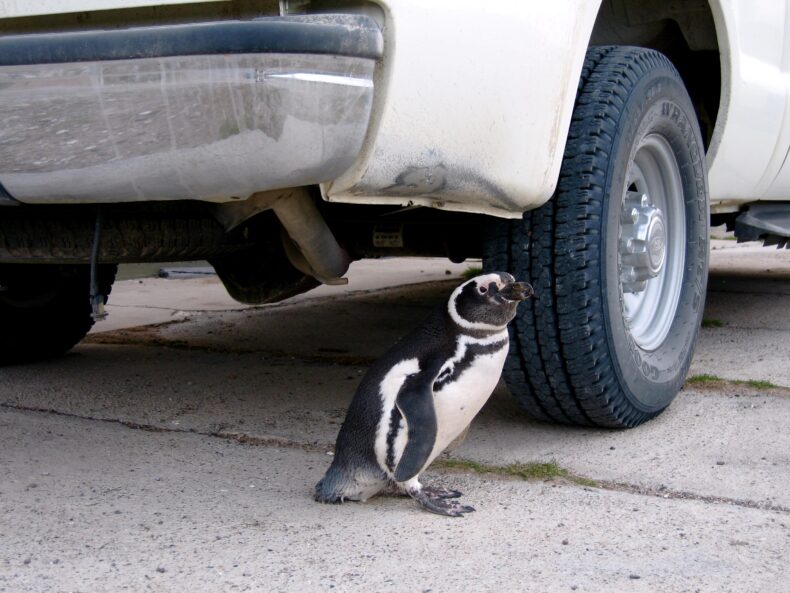
Turbo had been at Punta Tombo every year since. Magellanic penguins have an ageless quality, so no one knew how old he was, but penguins do not start breeding until they are four or five years of age. If 2005 was his first attempt, then he had to be at least 22 this year. Except he hadn’t been seen yet. Not to worry, I was assured. He would show up. He always did. It was just a matter of time.
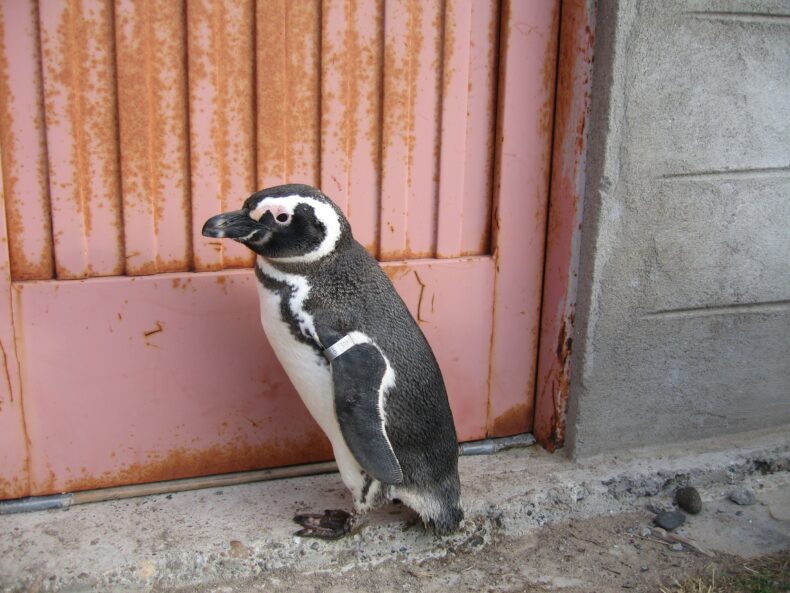
So it was that I headed out into the colony. The day was gorgeous, the vast Patagonian sky filled with puffy white clouds, while a cool wind blew from the south. Still, something wasn’t right. The first day at Tombo, the penguins should dazzle you. They are such wonderful creatures: about two feet tall, with black backs and white bellies, black bands across their necks and chests. Just so full of character. But the specter of bird flu made me nervous. I was dismayed, then, to find that, owing to this nervousness, I held the penguins at a bit of a remove. I was happy, of course, to see them as they strutted around or stared out at me from their nests, but I did not let myself fall into their world as I had in the past. I knew it was wrong, even cowardly. In my defense, I just wanted to be prepared if they all started to die.
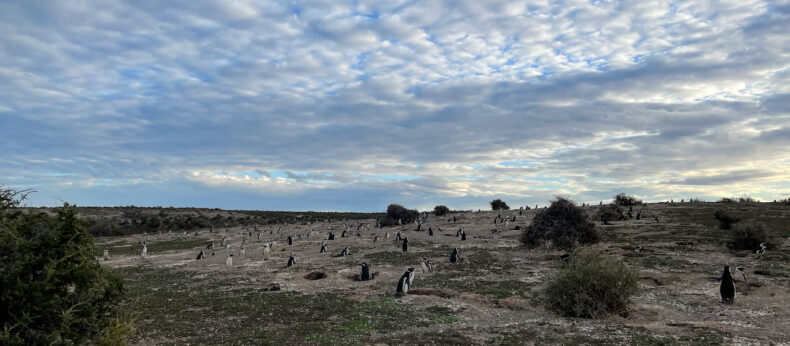
Bird flus are everywhere, all the time. Many viruses from a particular family cause them; H5N1 is merely the one that happens to be in the public eye at the moment. While it has been wreaking havoc on seabirds for more than two years now, H5N1 itself is not new. It was first identified in southern China in 1996, at a goose farm in Guangdong Province. It stayed in Asia until early 2006, when it was subsequently found in poultry in Africa and Europe. Millions of chickens, ducks, and turkeys have since died from H5N1, or been culled to prevent its spread. Then, sometime in 2020, a strain circulating among poultry swapped some genes with a strain circulating among wild birds, producing this new strain that for some reason is especially lethal to seabirds. And here we are.
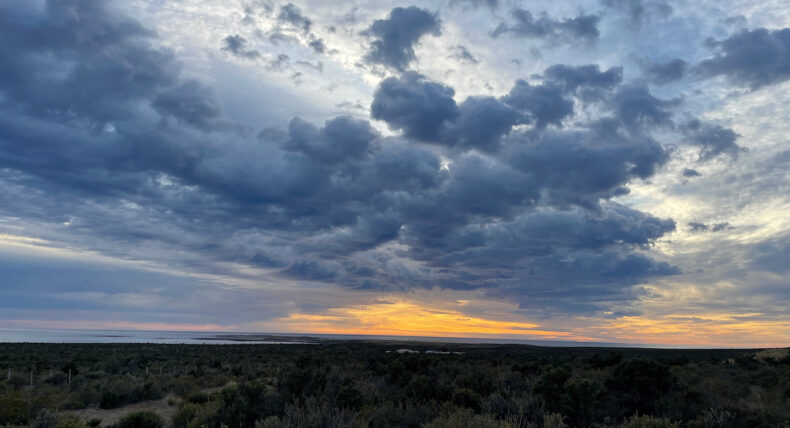
On the evening of my second day, Katie, Chloe, and I were out in the golden hour, weighing female penguins as they returned to the colony. Our aim was to see, in essence, how fat they were. Fatter females mean larger eggs. Larger eggs mean larger chicks. Larger chicks are more likely to fledge than smaller chicks. As a chain of being it was simple: bigger is better. And the females were big. Some weighed more than twelve pounds. It felt glorious to wrap a weigh strap around their hefty bodies and hoist them in the whipping cold wind, and then watch the spring scale dance before it settled on some large number. We had been weighing females for maybe ten or fifteen minutes when we saw a new one approach. Oh no, I thought.
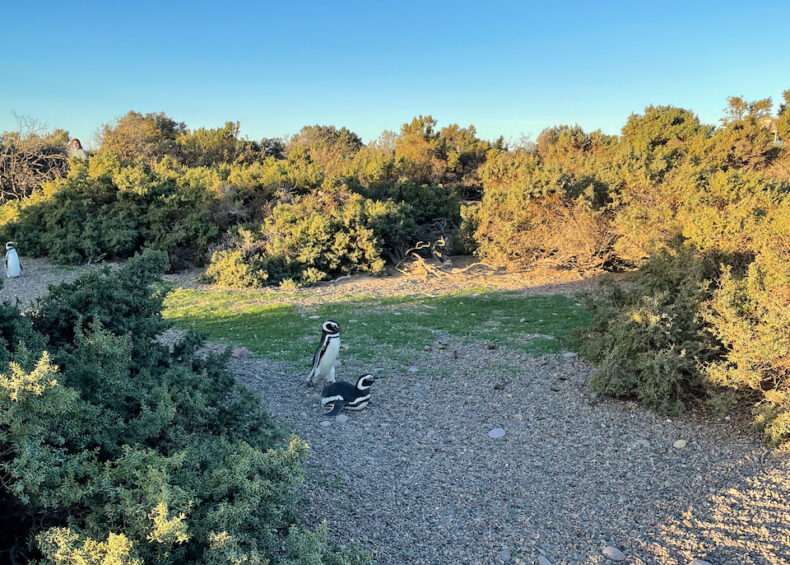
We could tell something was wrong with her right away. The way she walked. She would stagger a few steps, wobble, and then collapse onto her belly. She lay on the ground panting before trying to get up, failing, trying again, righting herself, tottering forward, now using her flippers to support herself, and flopping over again. Sometimes she shook her head as if to clear it. These, we had just learned, were classic early-onset symptoms of bird flu. Later would come the tremors, the catatonia, the respiratory distress, the death. Behind her was another female walking the same way. Twenty or so yards behind the second female was a third, also tottering. A short distance behind the third, a fourth.
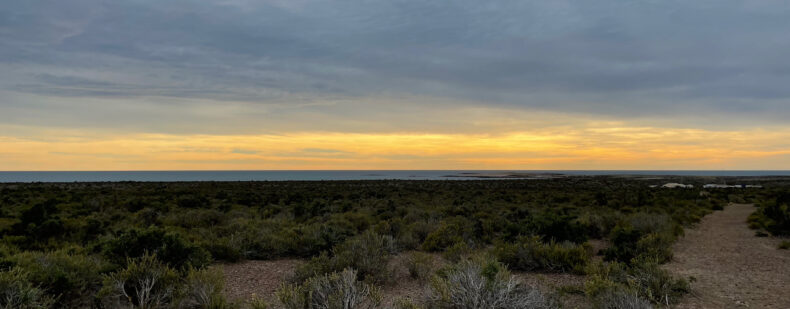
We stopped what we were doing to follow the females. The first went only as far as a small pedestrian bridge before she collapsed. A male sidled up to her and began a circle dance, which is a courtship display. He cared not a whit that she could not stand. The sex ratio at Tombo is such that there might be five males for every female. The males, therefore, will solicit any female not demonstrably mated with another male. The second female, meanwhile, hobbled past along one of the major paths into the colony, which we call penguin highways. I counted all the males that ran up to her, got right in her face. One… two… three… four… ten. All of them heedlessly crowding her while she staggered and flopped and shook her head and sprayed droplets. All of them eventually giving up and going back to their nests in bushes crowded with other penguins.
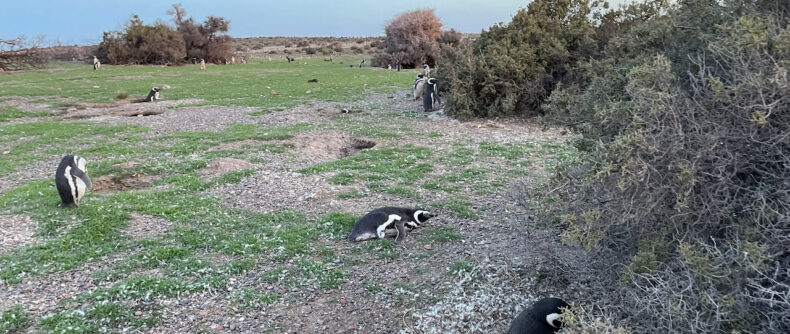
We walked back to the house in grim silence. I knew I wouldn’t be able to sleep, so rather than stare at the ceiling for hours in despair, I went for a long walk into the colony. It was a clear night, the sky watery bright. I could see the Southern Cross, the Magellanic clouds, Scorpio, other stars in accidental arrangement. All around me penguins brayed. Among them in all their vigor, I bargained fiercely. We had seen some wobbly females, true, and that sort of neurological impairment was characteristic of bird flu. But penguins wobble for a lot of reasons. Toxins from a harmful algal bloom, for instance. In years past, during such algal blooms, we would sometimes see what we called “drunk penguins.” This apparent drunkenness was due to algal toxins, which penguins ingested when eating anchovy or juvenile hake. Sometimes the birds looked like they would never walk again, but after a day or so they were often okay, the toxins flushed from their systems. I hoped beyond hope that what we were seeing was toxin, not flu. After hours of this desperate hoping, which might be called prayer, I made my way back to the house and, buzzing with exhaustion, collapsed on my bed and fell asleep at once.
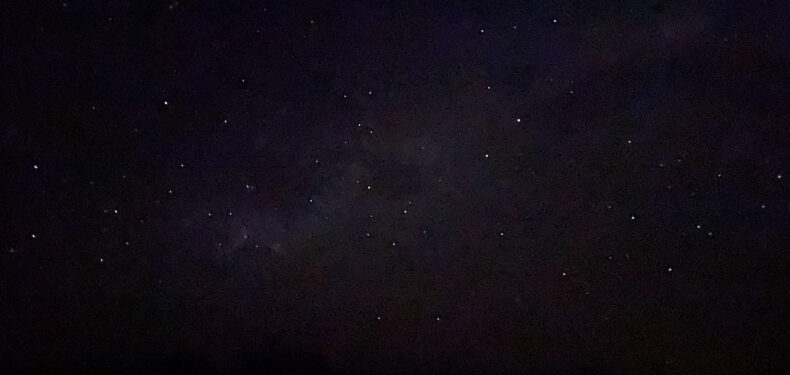
When I was at Tombo in 2008, Turbo visited almost every night. He would stand outside on the cracked cement stoop and rap on the door with his bill until we let him in. The first few times we squealed in delight, but soon the novelty of his attention wore off. “Hey, Turbo,” we would say as he toddled over the threshold. “How’s it going?” He would cluck in response—penguins cluck when they consider themselves to be in their own nests—and we would leave him be, attending to our tasks while he explored. Then, after some interval, he would get up to return to his bush for the night. He didn’t like to go alone, and so I would walk him back. As a domestic routine, it was one of the most memorable I’ve ever had. Turbo for his part didn’t seem especially ruffled. His expression as we scrunched over the gravel together was always perfectly serene. In his eyes he was simply spending time with other penguins. Who were we to tell him he wasn’t?
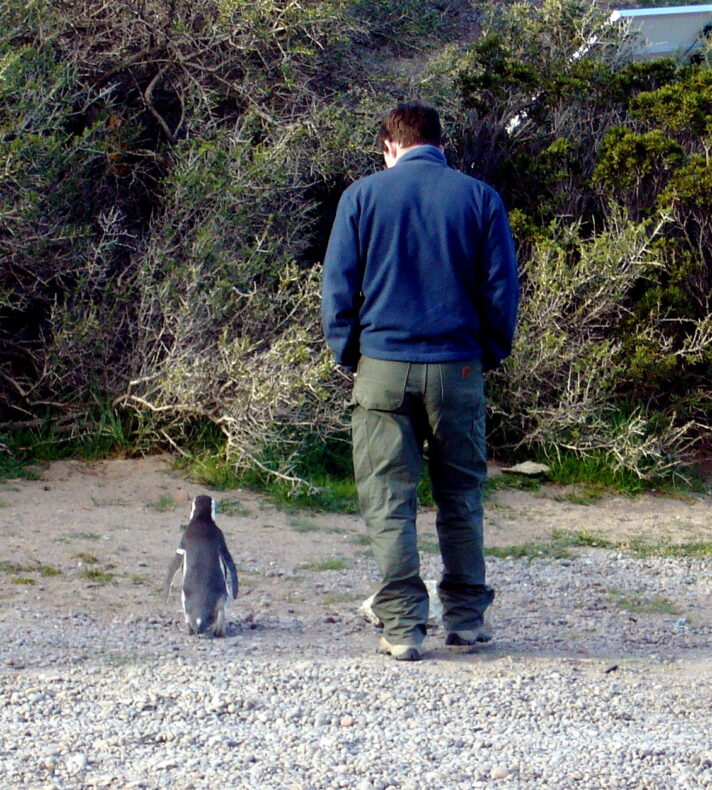
The next day was surreal. Word of what we had seen had spread fast. The great gears of bureaucracy were snorting to life. Four officials with the Department of Fauna and Flora drove out from the provincial capital to see for themselves what was happening at Tombo. We were to give them every photo, video, and GPS location we had of potential flu birds. Separately, officials from SENASA, akin to the U.S. Department of Agriculture, came to take samples from two of the impaired penguins. We would get the test results on Friday, we were told.
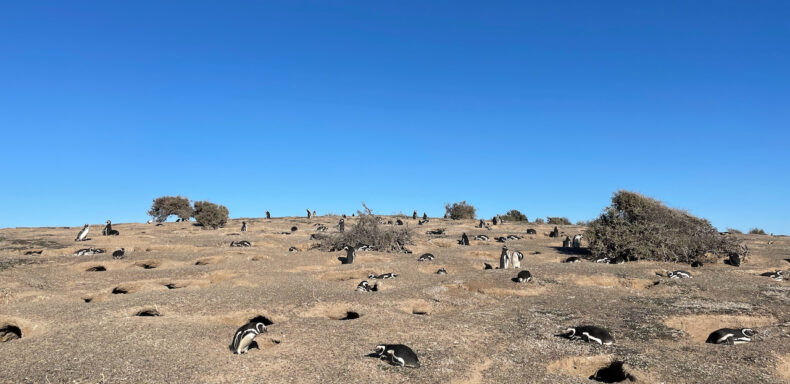
Katie, Chloe, and I stopped our regular research activities and went to different areas of the colony, peering into nests, trying to determine if the occupants were sick. We scanned the beaches for penguins that were having trouble walking. At dusk, we watched penguins come into the colony from the sea. I stationed myself on a bridge near the beach. Females were still arriving. Some had trouble getting up the hill, flopping down, propping themselves up on their flippers. Normally I would have loved this: females so fat that trudging up a slight incline was too much for them. Now they seemed harbingers of the viral apocalypse. But was this true? I worried I was losing my mind, that every penguin I saw was somehow symptomatic of bird flu simply because it was alive. That night I sent a message to a wildlife veterinarian I knew named Ralph. He worked in Puerto Madryn, about one hundred miles away, but he was driving up and down the coast searching for potentially affected animals. He said he would be in the area the next day and was happy to swing by Tombo.

I next saw Turbo late in November of 2015. I had finished my Ph.D. a few years before and left science for a time, but I was writing a book about penguins and so was down to remind myself what it was like at Tombo. (As if I could forget.) I was overjoyed to see the penguins again. One penguin in particular, of course. Even so, I was a touch nervous. Would he remember me? Imagine my glee, then, when he toddled out on hearing my voice. He was nesting in the same bush as in 2008, except now he lived in its outer fringe rather than its center. I felt the other penguins were shunting him to the side somehow, where he could be alone with his unconventional thoughts and habits and not bother anyone. But he seemed to be in good spirits, coming over to greet us whenever he was around. For three weeks he and I had our fill of pleasant exchanges. When I left I hoped I would see him again, but one could never predict the twists and turns a life might take.
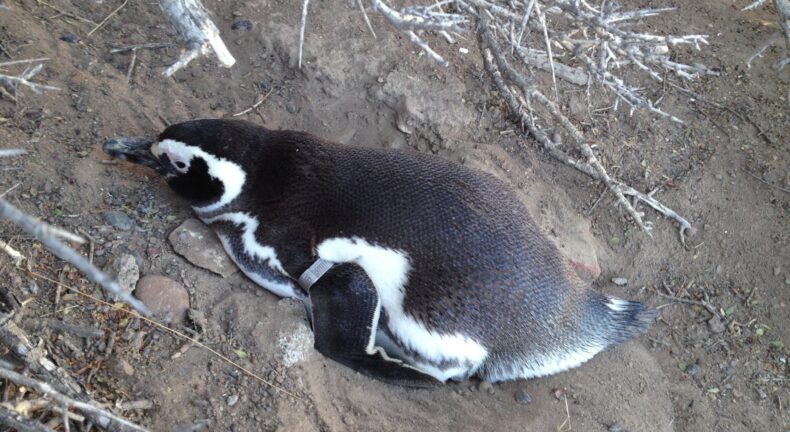
Ralph is Brazilian and in his late thirties, with short brown hair and a trim beard. When he pulled into Tombo and tumbled out of his car, he looked like he hadn’t slept for three days, which was perhaps the case. His glasses were held together in two places by two different types of tape. We all headed out to the colony. By then it had not been quite 36 hours since we had seen the first females. Other than a few more wobbly penguins here and there, we hadn’t seen hordes of diseased birds. I worried, oddly, that Ralph’s trip might end in disappointment—that he had driven out here for nothing, since we weren’t overrun. But we were not halfway down the main tourist trail through the colony when we all stopped and stared. “Oooh,” Ralph said. “I don’t like that.”
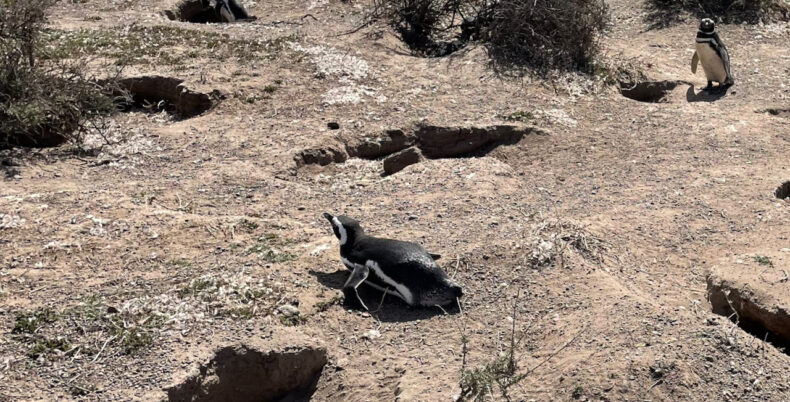
The penguin, a male, was twirling in wretched circles. His flippers flailed, and his neck was craned such that his head was halfway down his back. Sometimes he stumbled and fell, struggling to right himself. Other penguins ignored him, unless he veered too close to them, in which case they snapped at him. Tourists walked by without appearing to notice anything amiss. Ralph and Katie discreetly donned KN95 masks, and Katie caught the bird and held him while Ralph swabbed his bill and cloaca. Then, checking to make sure no one was watching, the two of them whipped off their masks and gloves and stood up, and it was like nothing was at all out of the ordinary.
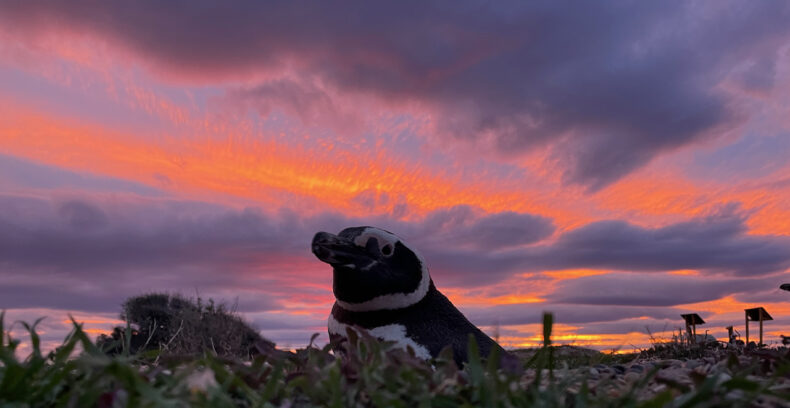
“It’s hard to say what this could be,” Ralph said when we were back at the house. Algal toxin and flu symptoms look a lot alike, and there was a certain uncertainty as to how H5N1 affects penguins, as opposed to skuas or gannets or terns, which it was known to ravage. He told us critical distinctions. Toxins from harmful algal blooms affect birds by impeding their neurotransmitters. “A bird suffering from toxin can’t do what it normally could do,” was how Ralph put it. Seabirds stricken while at sea might drown, because they don’t have the wherewithal to lift their heads above the water. Bird flu, on the other hand, causes the brain to swell, with different consequences. “A bird suffering from flu will do things it normally can’t do,” Ralph said. It was why he hadn’t liked that one penguin: the way he craned his neck so, twisting himself in knots. Ralph also told us not to trust the SENASA results out of hand. A positive result was definitely positive, but a negative result was not necessarily negative. Only with a dead bird in hand could one be absolutely sure. As for the swabs he had taken today, owing to a backlog at the lab, they wouldn’t be processed for weeks.
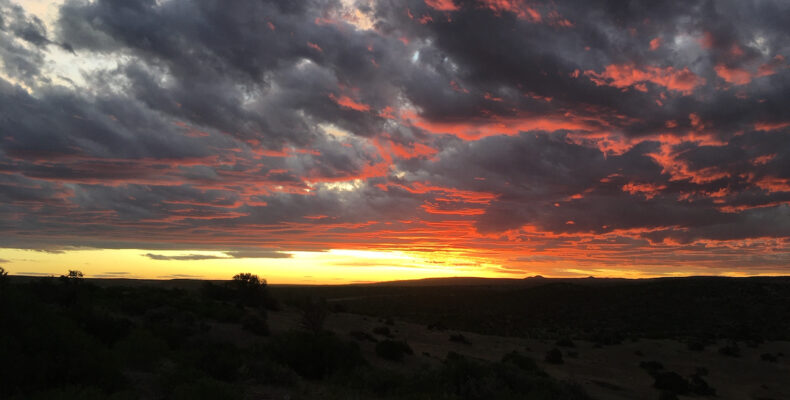
One other thing we learned from Ralph was that it was safe to work with the penguins—that we would endanger neither them nor ourselves. Cautiously we went back to our old routines. More and more pairs had formed, and within a few days we started to see the first eggs. Females lay two apiece, about four days apart. Both are the same volume, but the first tends to be longer and skinnier, the second shorter and squatter. For days we measured egg after egg, thrilling to their chalky feel, the subtle whorls on their shells, their warmth. It was nice to think of the colony as a colony again: a penguin-making factory, in other words, and one of the largest in the world at that.
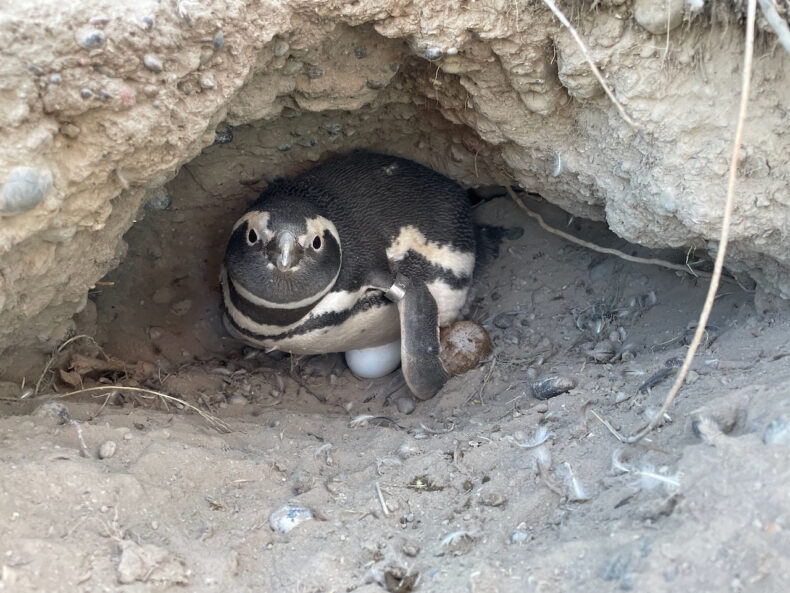
Friday brought no news from SENASA. I attributed their silence to creaking government bureaucracy. When Ralph asked if I’d heard anything, I said as much. That isn’t the best news, he wrote back. He suspected one of the samples was either positive or inconclusive, and so the authorities were testing it again to be sure. I sent a fretful message to Ginger, another researcher in the lab. In it I also mentioned that we still hadn’t seen Turbo. He could still show, she replied. But maybe it would be better for him if he didn’t. Dee, as is her wont, had a more optimistic read. Wait until October 20, she wrote, and then you can put on your doom-and-gloom hat.
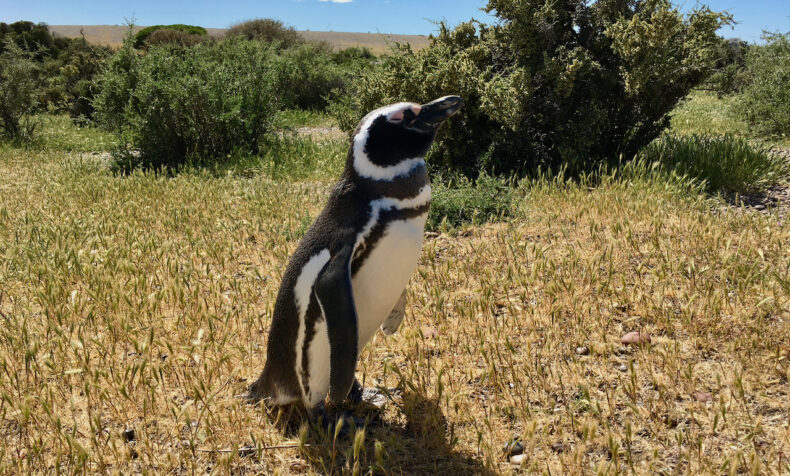
I next saw Turbo last year when I was here in October. Again, seven years had passed. Again, I wondered if he would remember me. Again, joy of joys, he did! Or seemed to. He was living in a spiny bush called quilimbay, just past the deli, souvenir shop, and small museum near the colony entrance. Turbo’s was the only active nest in the area so far as I could tell, in part because it was a third of a mile inland—a long toddle for a penguin. Perhaps this explains why, the first day I saw him, he was standing alone in front of the shop’s glass doors. By the copious sprays of guano, Turbo spent a lot of time there, considering his own reflection. Other times he wandered around the colony, a bit like a flâneur. One morning I took a photo of him braying: just him, his flippers flung wide, against the brown dirt of the parking lot, under a flat gray sky. He might have been the last penguin in the colony, yelling his defiance to the heavens.
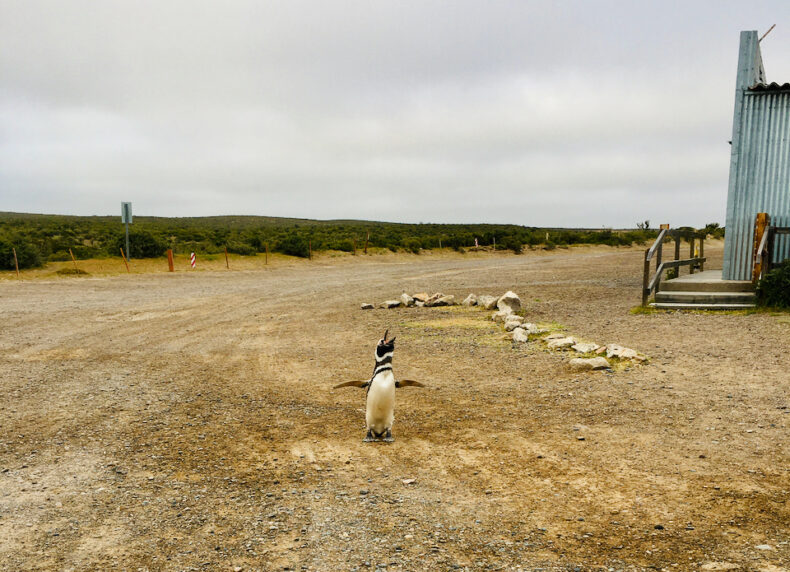
The following Tuesday, Luciano, one of the park rangers, told us the SENASA results had come back negative for bird flu. It was starting to look like we had had a toxic algal event after all. I wish I could say relief washed over me, but it did not. Any reprieve felt provisional at best. Ralph had pointed out that at a colony, bird flu might arrive in one of the less numerous species, and then move to the more abundant species. The penguins had likely escaped the worst for now, but they were not the only birds here.
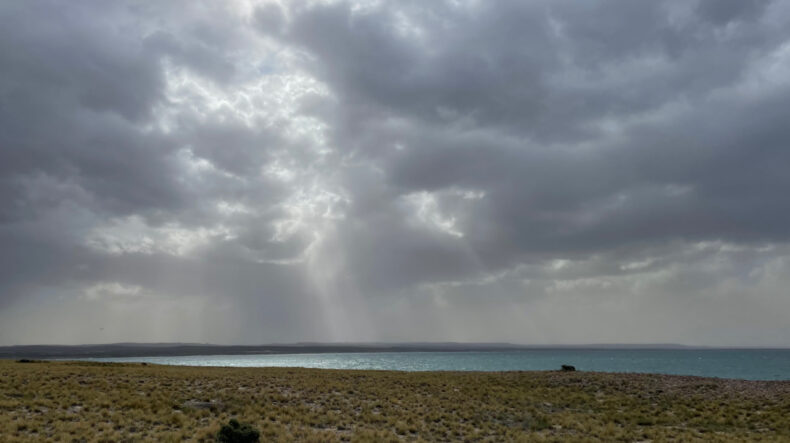
One other was the kelp gull. Tens of thousands nest a short distance from the heart of the penguin colony, on the point that gives Punta Tombo its name. Katie, Chloe, and I went to visit their colony one afternoon. We walked out through the pampas grass, past the bodies of some of the dead sea lions, to the rocks where the kelp gulls gathered en masse. They saw us coming a quarter mile away. Hundreds took to the air, calling their distress. Soon their guano rained down. Because of this, we stuck to the edge of their colony. From the rocks within thousands of gulls watched us. I could hear their natters of mild alarm, always in triplicate: muhp-muhp-muhp, muhp-muhp-muhp. We noted a few gulls sitting with their eyes closed, their heads shaking or bobbing, their wings outstretched. A few more were sprawled dead on the ground. I told myself they were all victims of toxic algae, nothing more.
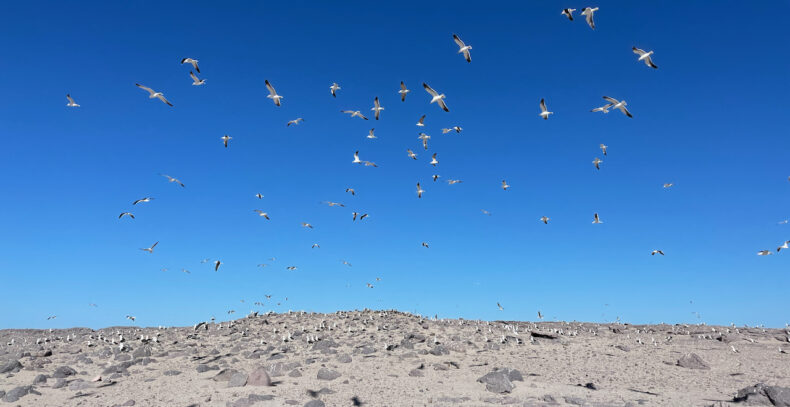
I last saw Turbo last April. I was at Tombo with Ginger to put satellite tracking tags on penguins once they finished molting and started their northward migration. As scientists, we spend so much of our time with penguins when they are on land. Humans that we are, it is more convenient for us, but the land is the barest sliver of a penguin’s life. Most of what matters to them happens at sea. These tags would help us start the most basic of sketches of where the penguins might be going when they left land, the marine features they like, the threats they face. When I got to Tombo, Turbo was in the midst of his molt. He looked like an overstuffed toy, his old feathers poofing out as new ones pushed up from his skin. Penguins molt all their feathers at once and are land-bound for a couple of weeks, so he was fasting, and grumpy. We hobnobbed some, but it was not as free and easy as it usually was. No matter, I thought. I would see him when I came back in October. Which was now.
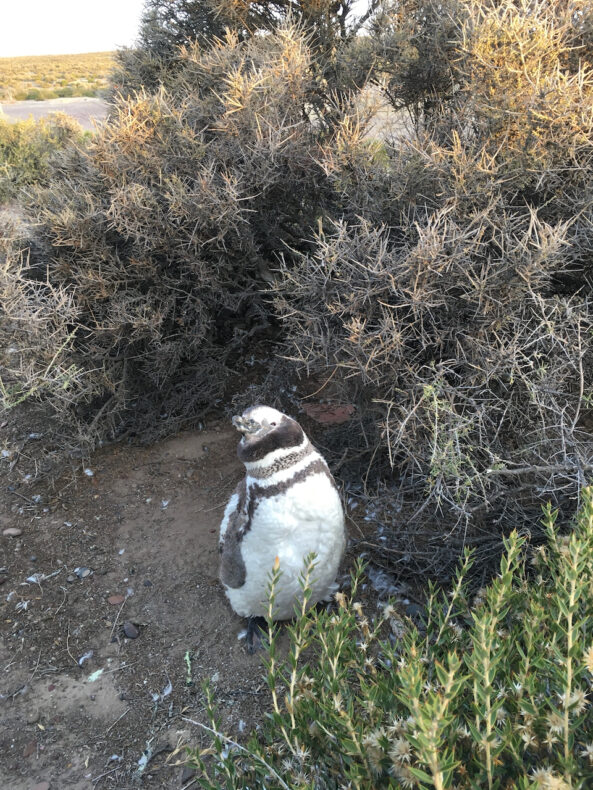
A few days later, Ralph messaged me: bird flu had been detected among the southern elephant seals on Peninsula Valdés, just north of Puerto Madryn. He and his colleagues had been out to three seal colonies and found more than one thousand dead pups and subadults. They suspected thousands more had died, perhaps 98% of the year’s pups, to go with some unknown number of adults. It was the largest die-off ever recorded for the species, at one of their largest assemblages in the world. The ecological consequences would be felt for years. As if that weren’t awful enough, a couple of thousand South American terns had also died of flu, their bodies littering the beaches. “It’s devastating,” Ralph said.
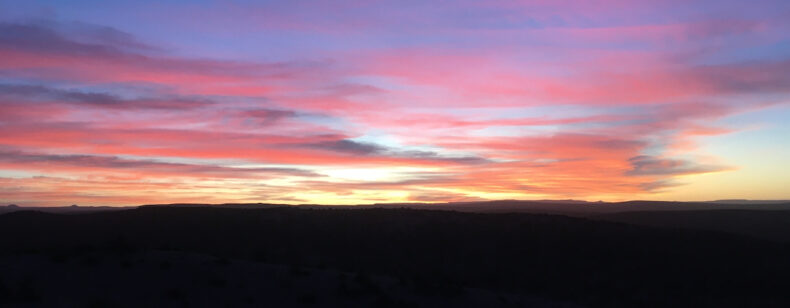
A couple of days after we found a single dead South American tern on the beach at Tombo. It was lying on its back, its wings folded so the ends of the long primaries crossed to make an X above the slender fork of its tail. Its bill and feet were a brilliant red against its white body and soft gray wings. It was breathtaking in its delicacy. We stood over it in silence. I love to watch terns fly. They are so buoyant, so free, like the wind made flesh and feather and hollow bone. Now the wind stirred the tern’s feathers. Not even death could rob it of its lightness.
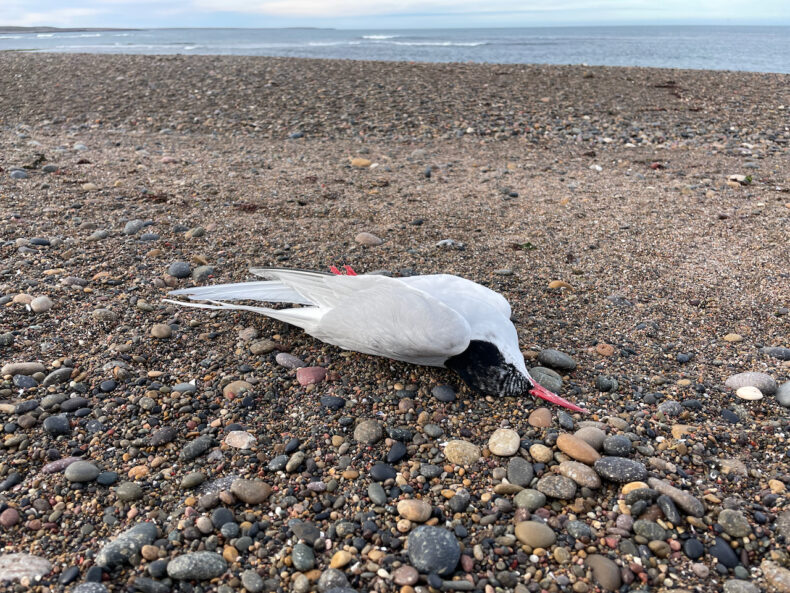
I went out to the kelp gull colony again, this time alone. The gulls whirled over my head, but, like before, they all appeared to be for the most part fine. I was glad they were fine, and glad, too, that the penguins had managed to avoid bird flu so far, but I felt guilty for being glad. There was a There but for the grace of God… tinge to my gladness that didn’t sit well. Had thousands of elephant seals and sea lions and terns died so the penguins would be spared? Of course not; that was not how bird flu worked. But it was hard to shake the feeling that a bargain of some sort had been made, even if I was not privy to its terms.
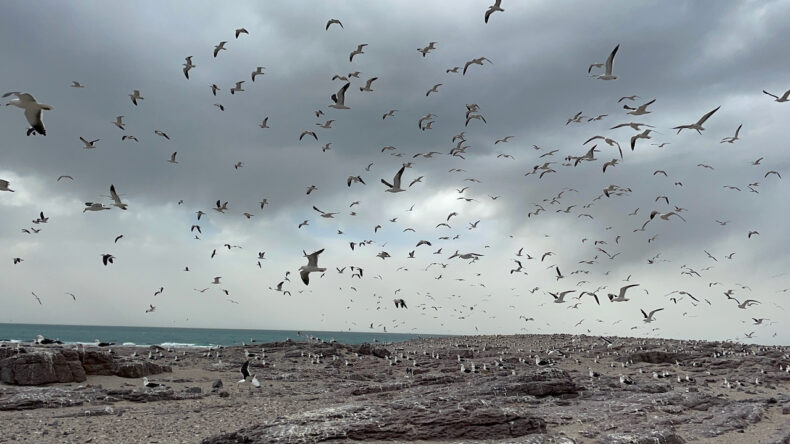
Or maybe I was. The 20th of October came and went with no sign of Turbo. Even though I think I had known for a while in my heart that he was dead, the truth of it hit harder than I was prepared for. Katie and I had earlier talked about how it felt to be at Tombo when Turbo for the first time was not. I was sad, yes, so sad, but now I found I was also grateful: that we were the ones to mark his absence and know what it meant; that we were the ones who could be here when he left us; that we, in a way, were the ones to close his eyes.
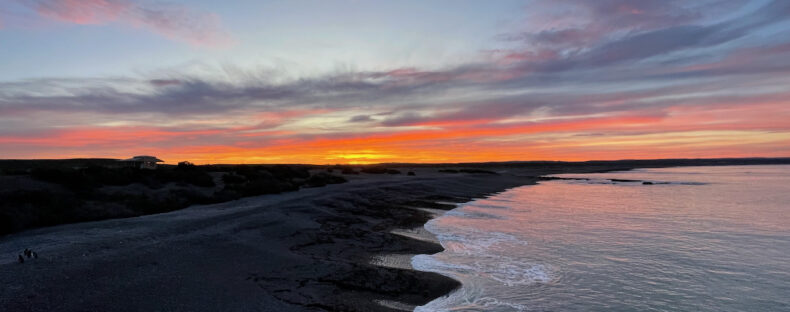
A few days before we were to leave, we all met Ralph again in Camarones, a small town about eighty miles south of Tombo. He was helping some volunteers work at a penguin colony outside of town, at a place called Cabo Dos Bahias. It was his birthday, and he invited us to a small get-together. At one point over sticky cake and beer, he explained how viral evolution works: some individual somehow gets infected with two viruses—bird flu and the common cold, for example—and within that individual the two viruses exchange genes. Suddenly a virus that until now has only been able to infect seabirds or marine mammals is able to infect humans, too. This is how pandemics start. “Now, I have a mild cold,” Ralph said. “And I’ve been around a lot of dead elephant seals. So, you know, the two viruses could be combining in my body.”
“Hm,” I said. “If you’re lucky, you could be Patient Zero.”
We all laughed.
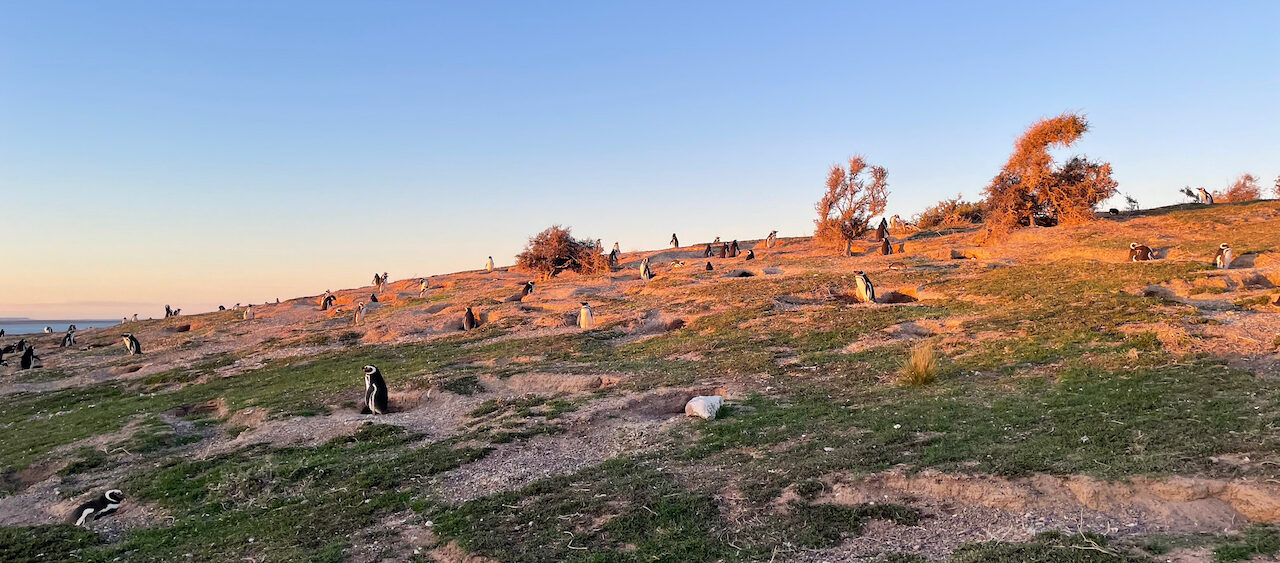
On my final day at Tombo, I made one last run to the gull colony. We would depart in the morning. How were we leaving the penguins? Much as we had found them, having a year like any other. Some were light and some heavy; some had mates and many did not; females laid eggs and the gulls or armadillos ate some of them; the colony continued its slow decline; and the sea rolled on as it rolled five thousand years ago.
The day was strange, unsettled. The weather app told me the skies would be clear and sunny all afternoon. The skies told me different. Huge gray clouds were blowing in from the northeast, dragging with them dense veils of rain. The wind was rising and rising and rising. The sea was a dark, roiled green.
I hunched against the wind and plodded to the gull colony. As always, the gulls saw me coming from far off and took to the air. The wind was so strong that they barely needed to flap; rather, they simply spread their wings and levitated. They soon filled all space, screaming at me. I walked under them, deeper into their colony, toward the center. I usually don’t do this, but I knew the gulls had no eggs yet, so there was no risk of destroying anything. I made it to the centroid under the whirling gulls, but there were no sick birds, so I retreated out to the colony’s edge. “Good luck!” I yelled into the wind.
I started back to the penguins. A dim haze ahead of me turned out to be a cloud of wind-lifted sand. It blew into me, tearing at my face and hands. Between the sand and the gulls’ screams I felt like I was being flayed, that Tombo was flaying me. But through the general cacophony I heard other calls: thinner, higher, raspier. Terns. They were in the spaces behind the gulls, whiter than white, like ghosts. The wind carried them; they moved impossibly fast without moving at all. They were flying south, but a few wheeled back against the wind somehow, hanging in the air. They floated, flicking their wings. Beneath the turbulent clouds, they looked like they were underwater. I watched them for as long as I could bear to keep my eyes open, and then I had to turn away, but not before I wished them all well.
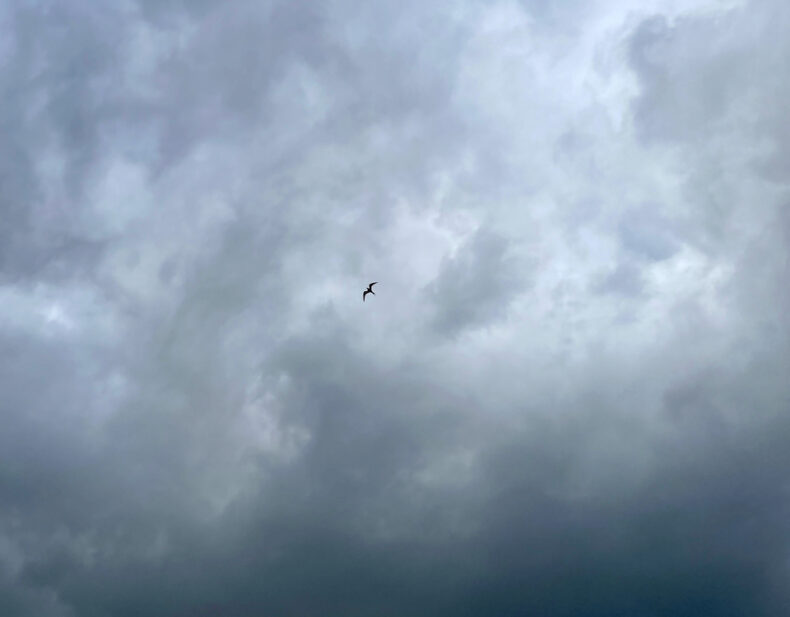
Never miss a story here, normally I glance at them in the morning, then finish reading when home. Could not put this one down, legs asleep (will skip why).… Amazing stuff! Thank you for writing it.
Thanks for the kind words, Dave! I hope your legs eventually woke up.
Oh, Eric, I’m not sure why reading your chronicle of awareness of possible contagion should feel like balm to me. It might have to do something with how you explore your sensitivity for what it reveals. Or, maybe how your meditation is not something that is over in a minute; it builds and builds and builds the way anticipation grows when walking in a particularly striking place where there will eventually be something even better to be seen.
Who knows? The world can be a lonely place, and I enjoy thinking about your birds more so than what my Friday-afternoon-before-Thanksgiving-Break currently has on offer. And so, you inspire me to use my free time this week for my own walks and explorations that have nothing to do with a holiday occasion I can only at this moment dread. We find peace and comfort where we will. Thank you.
Thanks, Rachel. Yes, the meditation definitely takes its time, and the world can indeed be a lonely place. But I like that idea, that through walking something better will eventually present itself. Maybe that’s why I walk so much; although the betterness is not always so obvious. I’m sorry you dread the holiday, and I hope your Friday-afternoon-before-Thanksgiving-Break walks and explorations have proven to be inspiring, soothing, or both.
RIP Turbo. You were the best penguin.
Truth.